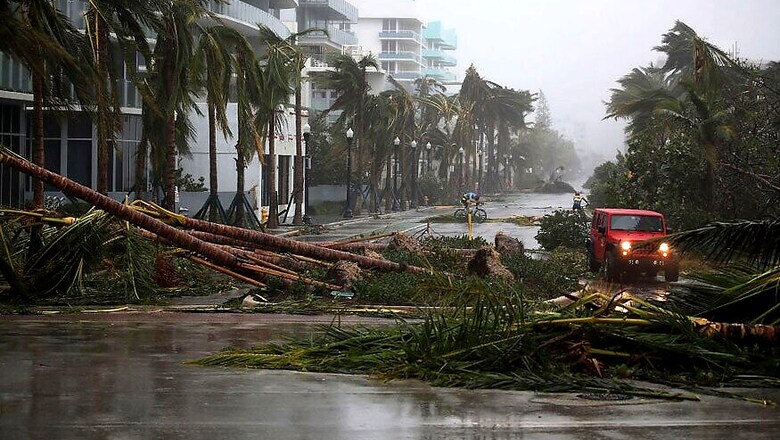
views
Miami: Hurricane Irma gave Florida a coast-to-coast pummeling with winds up to 130 mph on Sunday, swamping homes and boats, knocking out power to millions and toppling massive construction cranes over the Miami skyline.
The 400-mile-wide storm blew ashore in the mostly cleared-out Florida Keys, then began a slow trek up the state's west coast, its punishing winds extending clear across to Miami and West Palm Beach on the Atlantic side.
Before crashing into Florida, Hurricane Irma set all sorts of records for brute strength as it flattened Caribbean islands and swamped the Florida Keys. Irma's assault — so soon after Harvey's deluge of Houston — marked the first time the US was hit by two Category 4 storms in the same year.
However, when Irma hit the Sunshine State as a big wide beast, it, thankfully, was not quite the monster it once was shaping up to be. Earlier, it was the most powerful recorded storm in the open Atlantic. But as the once-Category 5 storm neared the US mainland, it lost some oomph after running into the northern coast of Cuba.
Still, at about 400 miles wide, it raked much of the state with devastating storm surge, destructive winds and drenching rains.
Florida can thank Cuba, where it did hit as a Category 5 storm, said Maue and Jeff Masters, meteorology director for Weather Underground. Irma would probably have hit Florida as a Category 5 hurricane if it had missed Cuba, Masters told The Associated Press.
Masters predicted that when Irma is done, it will go down as one of the five costliest hurricanes in US history, but not up with the top three of 2005's Hurricane Katrina, 2012's Sandy and this year's Harvey. Still, he guessed, it will be grouped with two other South Florida storms: 1992's Andrew and 2005's Wilma.
Irma's two US landfalls were unusually powerful. When Irma passed over the Florida Keys on Sunday morning its central pressure was the seventh lowest for a smack into the United States. Only the 1935 Labor Day storm, 1969's Camille, Katrina, Andrew, a 1886 Indianola, Texas, storm, and a 1919 Florida Keys storm were more intense based on atmospheric pressure. Irma ties the killer 1928 Lake Okeechobee hurricane.
Irma's second landfall on Marco Island, taken by itself, still would rank among the top couple dozen landfalls in intensity, slightly weaker than Harvey.
Irma set plenty of records, according to a two-page list compiled by Colorado State University researcher Phil Klotzbach:
— Its 185 mph winds were the highest on record for the open Atlantic ocean, outside the Gulf of Mexico and Caribbean sea. Only one other storm in the entire Atlantic basin — 1980's Allen — was stronger.
— It spent three consecutive days as a top-of-the-scale Category 5 hurricane, the longest in the satellite era.
— It generated the second most Accumulated Cyclone Energy — a key measurement that combines strength and duration — in the satellite era. Irma generated about as much as energy as entire normal Atlantic hurricane season.
— It was the strongest storm to hit the Leeward Islands.
— It's the first Category 5 hurricane to hit Cuba, which regularly gets assaulted by hurricanes, in nearly 100 years.
Irma was expected to reach the heavily populated Tampa-St. Petersburg area by early Monday, though in a much-weakened state.
"Pray, pray for everybody in Florida," Governor Rick Scott said on Fox News Sunday as more than 160,000 people waited out Irma in shelters statewide.
There were no immediate confirmed reports of any deaths in Florida in addition to the 24 people killed during Irma's destructive trek across the Caribbean.
(With inputs from Associated Press)


















Comments
0 comment